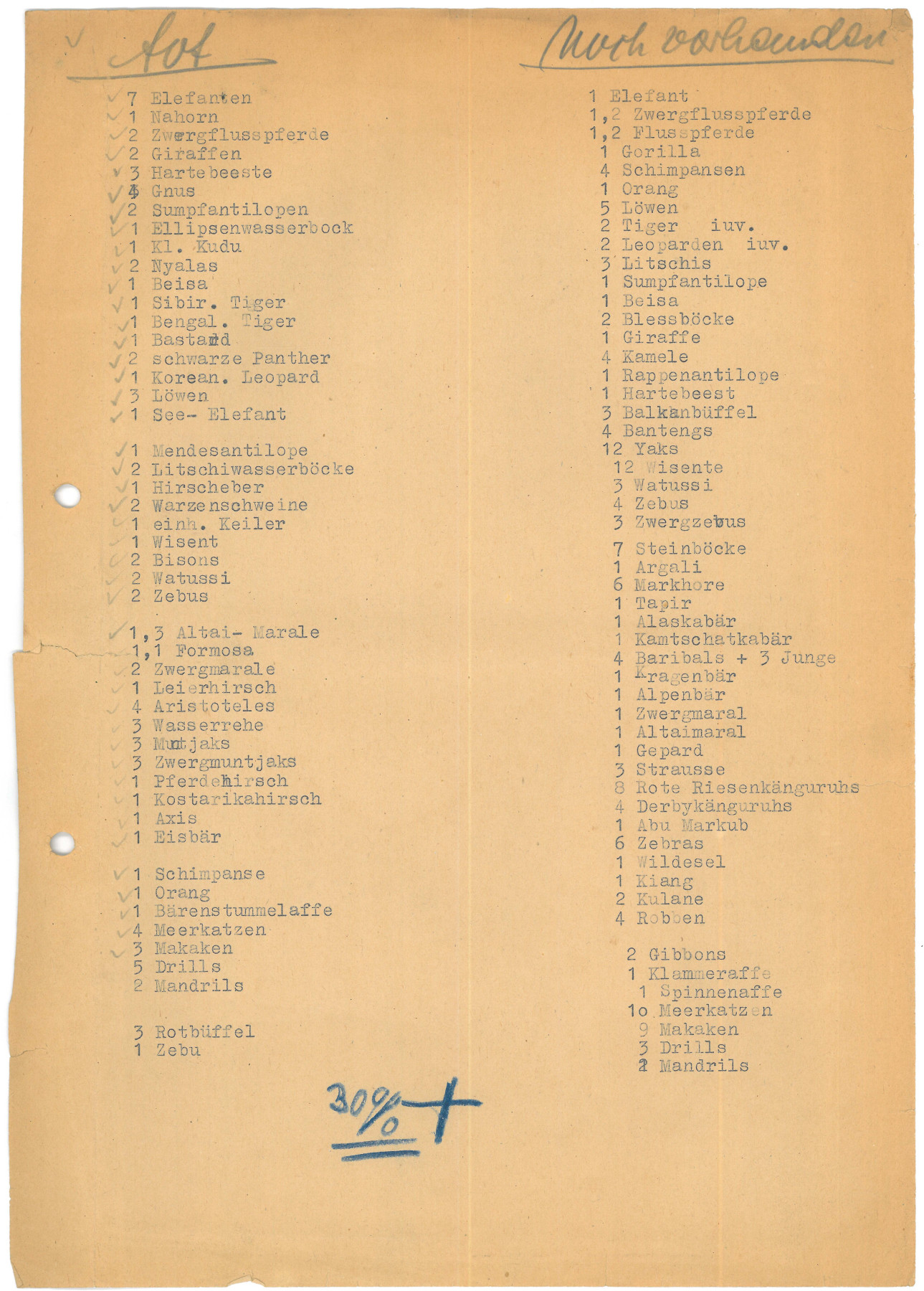
List of the animals killed at the Berlin Zoo in November 1943 (AZGB. All rights reserved.)
Both in the record-keeping systems in the collections of the  Zoological Museum (which was then part of the Natural History Museum) and in the inventory books from the
Zoological Museum (which was then part of the Natural History Museum) and in the inventory books from the  Zoological Teaching Collection of the Humboldt-Universität zu Berlin, we read that many animal objects were lost when Berlin was bombed in the night of 23 November 1943. But what about the zoo? A list from the Zoological Garden records the loss of live animals: 30% of the remaining animals were killed by bombs, by buildings collapsing, or by fire, or they were killed by
Zoological Teaching Collection of the Humboldt-Universität zu Berlin, we read that many animal objects were lost when Berlin was bombed in the night of 23 November 1943. But what about the zoo? A list from the Zoological Garden records the loss of live animals: 30% of the remaining animals were killed by bombs, by buildings collapsing, or by fire, or they were killed by  employees after escaping their enclosures. This document is an example of the practices of
employees after escaping their enclosures. This document is an example of the practices of  recording and managing inventories, arrivals, departures, and losses.
recording and managing inventories, arrivals, departures, and losses.
The only surviving elephant recorded in the list was  “Siam”. The numbers with commas, like ‘1,3’ for the Altai wapiti, note the sex in the manner of the
“Siam”. The numbers with commas, like ‘1,3’ for the Altai wapiti, note the sex in the manner of the  Steinmetz Index: one male Altai wapiti and three females died.
Steinmetz Index: one male Altai wapiti and three females died.
Transcript
[Left column] Dead
7 elephants / 1 rhinoceros / 2 pygmy hippopotamuses / 2 giraffes / 3 hartebeests / 4 gnus / 2 marshbucks / 1 waterbuck / 1 small kudu / 2 nyalas / 1 beisa / 1 Siber. tiger / 1 Bengal. tiger / 1 hybrid [of the two former species] / 2 black panthers / 1 Korean. leopard / 3 lions / 1 elephant seal
1 white antelope / 2 lechwe antelopes / 1 deer-pig / 2 warthogs / 1 one-horned boar / 1 wisent / 2 bison / 2 watusis / 2 zebus
1.3 Altai wapiti / 1,1 Formosa [Sika deer] / 2 Bachtrian wapiti / 1 Eld’s deer / 4 Aristoteles / 3 water deer / 3 muntjacs / 3 Chinese muntjacs / 1 sambar / 1 Costarican deer / 1 Axis [deer]/ 1 polar beer
1 chimpanzee / 1 orang / 1 king colobus / 4 guenons / 3 macaques / 5 drills / 2 mandrills
3 African forest buffalo / 1 zebu
30% †
[right-hand column] Still here
1 elephant / 1,2 pygmy hippopotamus / 1,2 hippopotamus / 1 gorilla / 4 chimpanzees / 1 orang / 5 lions / 2 tigers iuv. / 2 leopards iuv. / 3 lechwe / 1 marshbuck / 1 beisa / 2 blesbok / 1 giraffe / 4 camels / 1 sable antelope / 1 hartebeest / 3 Balkan buffalo / 4 bantengs / 12 yaks / 12 wisents / 3 watusi / 4 zebus / 3 miniature zebus / 7 ibex / 1 argali / 6 markhors / 1 tapir / 1 Kodiak bear / 1 Kamchatka brown bear / 4 American black bears + 3 cubs / 1 Asian black bear / 1 Alpine bear / 1 miniature maral / 1 Altai maral / 1 cheetah / 3 ostriches / 8 red kangaroos / 4 Lord Derby's kangaroos / 1 shoebill / 6 zebras / 1 wild donkey / 1 kiang / 2 kulans / 4 seals
2 gibbons / 1 spider monkeys / 1 woolly spider monkeys / 10 guenons / 9 macaques / 3 drills / 2 mandrills